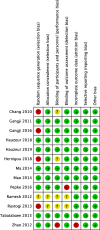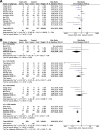Efficacy and safety of stem cell therapy for the early-stage osteonecrosis of femoral head: a systematic review and meta-analysis of randomized controlled trials
- PMID: 33076978
- PMCID: PMC7574494
- DOI: 10.1186/s13287-020-01956-5
Efficacy and safety of stem cell therapy for the early-stage osteonecrosis of femoral head: a systematic review and meta-analysis of randomized controlled trials
Abstract
Background: Osteonecrosis of femoral head (ONFH) is a seriously degenerative disease with no effective therapies to slow its progression. Several studies have reported short-term efficacy of stem cells on early-stage ONFH. However, its long-term effect was still unclear especially on progression events. This study was performed to evaluate the long-term efficacy and safety of stem cells and analyze its optimal age group and cell number.
Methods: Our review was registered on PROSPERO ( http://www.crd.york.ac.uk/PROSPERO ), registration number CRD42020136094. Following PRISMA guideline, we searched 8 electronic databases on January 5, 2020, and rigorous random controlled trials (RCTs) utilizing stem cell therapy on early-stage ONFH were included. Quality and bias were analyzed. Pooled analysis was performed to assess difference between various outcomes.
Results: A total of 13 RCTs (619 patients with 855 hips) were included. The application of stem cells significantly delayed collapse of femoral head(I2, 70%; RR, 0.54; 95% CI, 0.33 to 0.89; P < .00001) and total hip replacement (THR) (I2, 68%; RR, 0.55; 95% CI, 0.34 to 0.90; P = .02) in the long term. It effectively decreased the events of collapse of femoral head (≥ 60 months) (I2, 0%; RR, 0.37; 95% CI, 0.28 to 0.49; P < .00001) and THR (> 36 months) (I2, 0%; RR, 0.32; 95% CI, 0.23 to 0.44; P < .00001). There existed a beneficial effect for patients under 40 (Collapse of femoral head: I2, 56%; RR, 0.41; 95% CI, 0.23 to 0.76; P = .004) (THR: I2, 0%; RR, 0.31; 95% CI, 0.23 to 0.42; P < .00001). In addition, quantity of stem cells at 108 magnitude had better effects on disease progression events (I2, 0%; RR, 0.34; 95%CI, 0.16 to 0.74; P = .007). Besides, there were no significant differences on adverse events between the stem cell group and control group (I2, 0%; RR, 0.82; 95% CI, 0.39 to 1.73; P = .60).
Conclusion: Our findings build solid evidence that stem cell therapy could be expected to have a long-term effect on preventing early-stage ONFH patients from progression events, such as collapse of femoral head and total hip replacement. Furthermore, patients under 40 may be an ideal age group and the optimal cell number could be at 108 magnitude for this therapy. Further studies including strict RCTs are required to evaluate a clear effect of stem cells on ideal patient profile and the procedures of implantation.
Keywords: Collapse of femoral head; Meta-analysis; Osteonecrosis of femoral head; Progression events; Stem cells; Total hip replacement.
Conflict of interest statement
The authors declare that they have no competing interests.
Figures
Similar articles
-
Efficacy and safety of traditional Chinese medicine in the treatment of osteonecrosis of the femoral head.J Orthop Surg Res. 2023 Aug 14;18(1):600. doi: 10.1186/s13018-023-04086-9. J Orthop Surg Res. 2023. PMID: 37580744 Free PMC article.
-
Does Adjunction of Autologous Osteoblastic Cells Improve the Results of Core Decompression in Early-stage Femoral Head Osteonecrosis? A Double-blind, Randomized Trial.Clin Orthop Relat Res. 2023 Aug 1;481(8):1527-1540. doi: 10.1097/CORR.0000000000002610. Epub 2023 Mar 24. Clin Orthop Relat Res. 2023. PMID: 36961220 Free PMC article. Clinical Trial.
-
Efficacy of bone marrow stem cells combined with core decompression in the treatment of osteonecrosis of the femoral head: A PRISMA-compliant meta-analysis.Medicine (Baltimore). 2020 Jun 19;99(25):e20509. doi: 10.1097/MD.0000000000020509. Medicine (Baltimore). 2020. PMID: 32569171 Free PMC article.
-
Clinical evaluation of platelet-rich plasma therapy for osteonecrosis of the femoral head: A systematic review and meta-analysis.PLoS One. 2024 May 24;19(5):e0304096. doi: 10.1371/journal.pone.0304096. eCollection 2024. PLoS One. 2024. PMID: 38787864 Free PMC article.
-
The efficacy of targeted intraarterial delivery of concentrated autologous bone marrow containing mononuclear cells in the treatment of osteonecrosis of the femoral head: a five year follow-up study.Bone. 2013 Dec;57(2):509-16. doi: 10.1016/j.bone.2013.08.022. Epub 2013 Aug 29. Bone. 2013. PMID: 23994171 Free PMC article. Clinical Trial.
Cited by
-
"SAVE"-Shock-Assisted Viable Extraction: A Minimally Manipulative Method of Processing Regenerative Cells for Clinical Use.Aesthet Surg J Open Forum. 2024 Nov 19;7:ojae112. doi: 10.1093/asjof/ojae112. eCollection 2025. Aesthet Surg J Open Forum. 2024. PMID: 39790718 Free PMC article.
-
Case report: Directional infusion of peripheral blood stem cells into the necrotic zone in femoral heads through the medial circumflex femoral artery: A tracing study.Front Med (Lausanne). 2022 Aug 18;9:945268. doi: 10.3389/fmed.2022.945268. eCollection 2022. Front Med (Lausanne). 2022. PMID: 36059815 Free PMC article.
-
Cyclic Polypeptide D7 Protects Bone Marrow Mesenchymal Cells and Promotes Chondrogenesis during Osteonecrosis of the Femoral Head via Growth Differentiation Factor 15-Mediated Redox Signaling.Oxid Med Cell Longev. 2022 Mar 3;2022:3182368. doi: 10.1155/2022/3182368. eCollection 2022. Oxid Med Cell Longev. 2022. PMID: 35281469 Free PMC article.
-
Knowledge structure and emerging trends on osteonecrosis of the femoral head: a bibliometric and visualized study.J Orthop Surg Res. 2022 Mar 28;17(1):194. doi: 10.1186/s13018-022-03068-7. J Orthop Surg Res. 2022. PMID: 35346273 Free PMC article. Clinical Trial.
-
The efficacy of core decompression combined with regenerative therapy in early femoral head necrosis: a systematic review and meta-analysis involving 954 subjects.Front Pharmacol. 2025 Jan 7;15:1501590. doi: 10.3389/fphar.2024.1501590. eCollection 2024. Front Pharmacol. 2025. PMID: 39840080 Free PMC article. Review.
References
-
- Zha X, Sun B, Zhang R, Li C, Yan Z, Chen J. Regulatory effect of microRNA-34a on osteogenesis and angiogenesis in glucocorticoid-induced osteonecrosis of the femoral head. J Orthop Res. 2018;36(1):417–424. - PubMed
-
- Leunig M, Ganz R. The evolution and concepts of joint-preserving surgery of the hip. Bone Joint J. 2014;96-B(1):5–18. - PubMed
Publication types
MeSH terms
LinkOut - more resources
Full Text Sources





